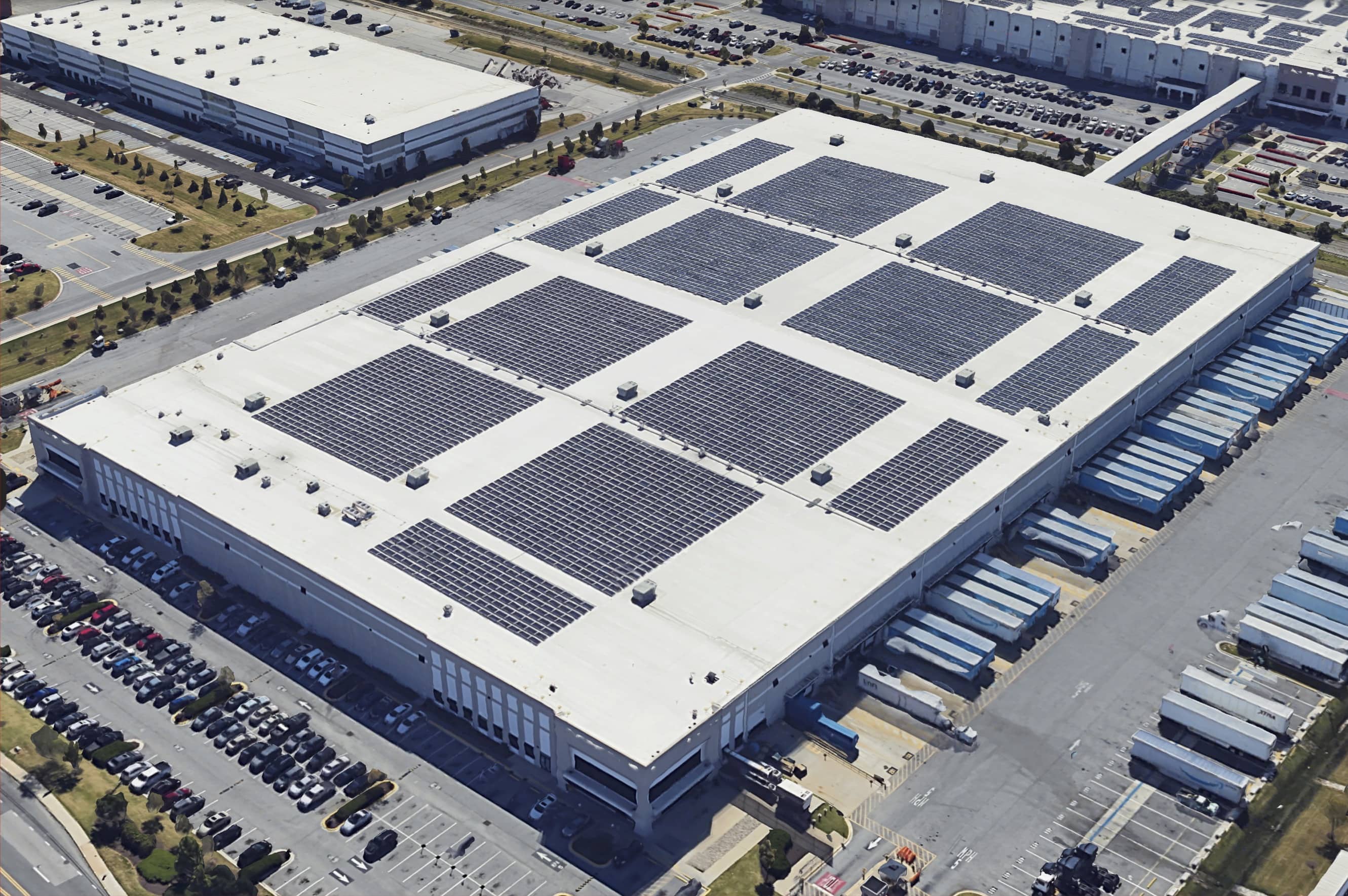
www.buildingsandcities.org/insights/commentaries/data-politics-tech-corporations.html
The Data Politics of Tech Corporations

Have civil society and governments ceded too much power and influence to a few tech corporations? Why analysis of the smart city needs to include private sector data.
Dillon Mahmoudi (University of Maryland, Baltimore County) and Alan Wiig (University of Florida) comment on the contributions of the Buildings & Cities special issue Data Politics in the Built Environment. This commentary considers how tech corporates such as Amazon are changing urban life and creating new forms of automated surveillance.
The timely collection of essays in the Buildings & Cities special issue 'Data Politics in the Built Environment' makes the case that scholars, practitioners and activists working towards more equitable and just cities must consider the politics of data. This commentary considers Sharma et al.'s (2023, p. 316, citing Kitchin 2021) provocation for scholars critical of the techno-utopianism of the smart city to 'trouble' the topic by directly addressing 'the injustices inherent to contemporary visions of [smart cities]'. Their paper calls for an intersectional approach that 'seeks to understand the dynamics of interaction between different oppressions showing how different oppressions shape and impact one another' (Sharma et al. 2023, p. 318).
The present commentary considers how corporate surveillance capitalism (Sareen et al. 2023, p. 613; citing Zuboff 2019) produces and reproduces the 'actually existing smart city' (Shelton et al. 2015; Mackinnon et al. 2022). Over the last decade-plus a few large firms have taken over foundational aspects of the urban, high-street economy of shopping, socialising and entertainment, but also embody many of the problematic and profitable elements of the smart city including automated surveillance and the rapid and efficient, digitised management of goods, services and workers.
In turn, this raises a challenge for urban scholars to think beyond the traditional data production and governance boundaries to include the economic activities that take place in the peripheral zones that so often house the warehouses and distribution centres (e.g. Amazon and its competitors). These spaces may sit outside the regulatory reach of municipal officials working on smart city projects (and on a city's management in general), but as Amazon's warehouses have replaced a city's brick and mortar storefronts, the corporation has taken on an outsize role in everyday urban life.
A brief illustrative case is presented to summarise ongoing research in Baltimore, Maryland, US. Baltimore is a coastal port city that rose to prominence in the 19th century with industrial manufacturing, shipbuilding, steel production and sprawling transshipment railways and ports (Liebel 2006). Since the 1960s the city has seen significant social and economic decline marked by population loss and urban decay.
Today, on the formerly industrial waterfront is one of the largest Amazon fulfilment centres in the country. About 1,500 employees work in a windowless, 95,000 m2 facility that processes tens if not hundreds of thousands of packages a day and a short 6 km (4 miles) from the city centre (MacGillis 2021). Where once molten steel flowed to produce machinery and consumer commodities, bits now flow on the silicon microchips of robots and data servers to manage the efficient movement of commodities made in factories elsewhere, typically in Asia or Central America. From the outside, the structure appears as an anonymous, low-slung, windowless building complex surrounded by asphalt parking lots near a major freeway exchange. A constant stream of tractor trailers come and go from delivery docks, producing real time data on delivery status as each package is scanned during loading or offloading. Inside, the company houses a fulfilment centre made possible by cutting-edge technology and labour practices. Despite earning over $18 per hour, workers face challenging conditions and the inevitable threat of being laid-off due to automation, a stark contrast to the unionized waterfront labour of the 19th and 20th centuries. Warehouse workers labour alongside 'Pegasus' and 'Proteus' robots that aid in moving boxed stacks of products to the right location to be packed for delivery.
Amazon's digital services are inseparable from the act of shopping online and then receiving a package: Amazon Web Services' (AWS) data management is the backbone that makes the logistics of rapid package delivery a reality (Shane 2019). The interconnected systems maximize efficient distribution from production facility to fulfilment centre and then to customers' doorsteps, including the movement of products between different types of warehouses and distribution locations. For example, two more large Amazon regional sorting facilities (near to the Baltimore fulfilment centre) direct packages to the right location whether in Baltimore or elsewhere. In nearby Dundalk there are three more robotic large fulfilment centres and a delivery station network facility which serves the Washington D.C. metropolitan area and Maryland more broadly. Amazon's Prime Air delivers to these facilities through the Baltimore-Washington International Airport (BWI). Amazon's BWI cargo hub has separate delivery station hubs, its own fulfilment centre and a regional sorting facility. Prime Air moves more cargo through BWI than the global logistics companies FedEx and UPS combined, even though Prime Air is much newer than the other two.
The same AI-powered digital services that serve as the backbone of Amazon's logistics are also a source of revenue from cloud computing clients. Amazon's digital and cloud services account for one-third of the global $200 billion cloud computing market. Amazon's digital services seep into the city, like the historic Camden Yards stadium where the Baltimore Orioles professional baseball team play and the M&T Bank Stadium where the Baltimore Ravens professional American football team play. Amazon servers record, store and analyse every athlete's movement to find a competitive edge over other teams. Software running on Amazon servers match the video feed with the identifying microchips in helmets and shoulder pads of professional football players to analyse play patterns (Shane 2019). Radar tracks and records every pitch during a baseball game to maximize the effectiveness of both pitching and hitting. TV networks crunch analysis in real time to produce flashy infographics that loudly display an 'AWS-powered' logo for viewers, some of whom may be watching live on Amazon's Prime Video streaming service.
Amazon Web Services also serves as the digital backend for Amazon products, like the infamous Alexa-enabled smart speaker devices and Ring security cameras. After a rash of recent home burglaries and crimes in northern Baltimore, Amazon helped a group of Baltimore pastors secure $15,000 in funding to purchase Ring security cameras for neighbourhood residents. These networked cameras, together dubbed 'Operation On Guard' (Rector 2019), provide the Baltimore Police Department with a vast array of front door surveillance cameras that complement the nearly 780 Baltimore Police CCTV cameras and 235 AWS-powered ShotSpotter gunshot detection units that disproportionately surveil non-white neighbourhoods.
To conclude, the data politics of the smart city must include the proprietary private sector data that drives Amazon's business model. The promises of government efficiency, sustainability and openness that form the foundation of plans for smart cities (Wiig 2016) have been transformed through the profit-driven politics of global corporations. This has direct consequences for cities and urban life. Have civil society and governments ceded too much power and influence to a few corporations?
References
Liebel, T. (2006). Industrial Baltimore. Arcadia Publishing Library Editions.
Mackinnon, D., Burns, R. & Fast, V. (Eds.). (2022). Digital (In)justice in the Smart City. University of Toronto Press.
MacGillis, A. (2021). Fulfillment: Winning and Losing in One-Click America. New York: Farrar, Straus and Giroux.
Rector, K. (2019, August 21). 'Virtual neighborhood watch': Baltimore faith group building surveillance network with help from Amazon Ring. Baltimore Sun. https://www.baltimoresun.com/2019/08/21/virtual-neighborhood-watch-baltimore-faith-group-building-surveillance-network-with-help-from-amazon-ring/
Sareen, S., Smith, A., Gantioler, S., Balest, J., Brisbois, M.C., Tomasi, S., Sovacool, B., Torres Contreras, G.A., DellaValle, N. & Haarstad, H. (2023). Social implications of energy infrastructure digitalisation and decarbonisation. Buildings and Cities, 4(1), 612-628.
Shane, S. (2019, November 30). Prime mover: how Amazon wove itself into the life of an American city. New York Times. www.nytimes.com/2019/11/30/business/amazon-baltimore.html
Sharma, N., Hargreaves, T. & Pallett, H. (2023). Social justice implications of smart urban technologies: An intersectional approach. Buildings and Cities, 4(1), 315-333.
Shelton, T., Zook, M. & Wiig, A. (2015). The 'actually existing smart city'. Cambridge Journal of Regions, Economy and Society, 8(1), 13-25.
Wiig, A. (2016). The empty rhetoric of the smart city: from digital inclusion to economic promotion in Philadelphia. Urban Geography, 37(4), 535-553.
Latest Peer-Reviewed Journal Content
Youth engagement in urban living labs: tools, methods and pedagogies
N Charalambous, C Panayi, C Mady, T Augustinčić & D Berc
Co-creating urban transformation: a stakeholder analysis for Germany’s heat transition
P Heger, C Bieber, M Hendawy & A Shooshtari
Placemaking living lab: creating resilient social and spatial infrastructures
M Dodd, N Madabhushi & R Lees
Church pipe organs: historical tuning records as indoor environmental evidence
B Bingley, A Knight & Y Xing
A framework for 1.5°C-aligned GHG budgets in architecture
G Betti, I Spaar, D Bachmann, A Jerosch-Herold, E Kühner, R Yang, K Avhad & S Sinning
Net zero retrofit of the building stock [editorial]
D Godoy-Shimizu & P Steadman
Co-learning in living labs: nurturing civic agency and resilience
A Belfield
The importance of multi-roles and code-switching in living labs
H Noller & A Tarik
Researchers’ shifting roles in living labs for knowledge co-production
C-C Dobre & G Faldi
Increasing civic resilience in urban living labs: city authorities’ roles
E Alatalo, M Laine & M Kyrönviita
Co-curation as civic practice in community engagement
Z Li, M Sunikka-Blank, R Purohit & F Samuel
Preserving buildings: emission reductions from circular economy strategies in Austria
N Alaux, V Kulmer, J Vogel & A Passer
Urban living labs: relationality between institutions and local circularity
P Palo, M Adelfio, J Lundin & E Brandão
Living labs: epistemic modelling, temporariness and land value
J Clossick, T Khonsari & U Steven
Co-creating interventions to prevent mosquito-borne disease transmission in hospitals
O Sloan Wood, E Lupenza, D M Agnello, J B Knudsen, M Msellem, K L Schiøler & F Saleh
Circularity at the neighbourhood scale: co-creative living lab lessons
J Honsa, A Versele, T Van de Kerckhove & C Piccardo
Positive energy districts and energy communities: how living labs create value
E Malakhatka, O Shafqat, A Sandoff & L Thuvander
Built environment governance and professionalism: the end of laissez-faire (again)
S Foxell
Co-creating justice in housing energy transitions through energy living labs
D Ricci, C Leiwakabessy, S van Wieringen, P de Koning & T Konstantinou
HVAC characterisation of existing Canadian buildings for decarbonisation retrofit identification
J Adebisi & J J McArthur
Simulation and the building performance gap [editorial]
M Donn
Developing criteria for effective building-sector commitments in nationally determined contributions
P Graham, K McFarlane & M Taheri
Join Our Community

The most important part of any journal is our people – readers, authors, reviewers, editorial board members and editors. You are cordially invited to join our community by joining our mailing list. We send out occasional emails about the journal – calls for papers, special issues, events and more.
We will not share your email with third parties. Read more



Latest Commentaries
COP30 Report
Matti Kuittinen (Aalto University) reflects on his experience of attending the 2025 UN Conference of the Parties in Belém, Brazil. The roadmaps and commitments failed to deliver the objectives of the 2025 Paris Agreement. However, 2 countries - Japan and Senegal - announced they are creating roadmaps to decarbonise their buildings. An international group of government ministers put housing on the agenda - specifying the need for reduced carbon and energy use along with affordability, quality and climate resilience.
Building-Related Research: New Context, New Challenges
Raymond J. Cole (University of British Columbia) reflects on the key challenges raised in the 34 commissioned essays for Buildings & Cities 5th anniversary. Not only are key research issues identified, but the consequences of changing contexts for conducting research and tailoring its influence on society are highlighted as key areas of action.